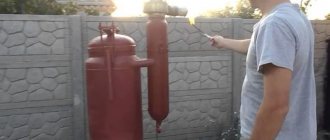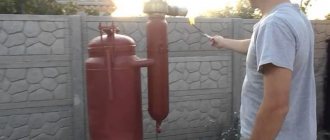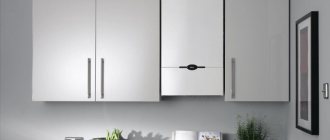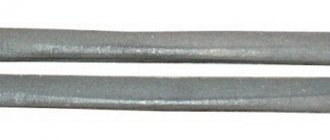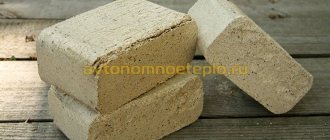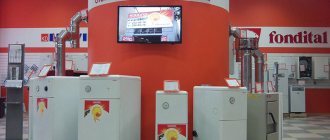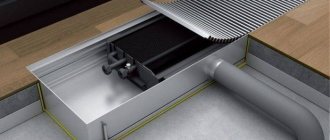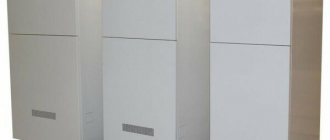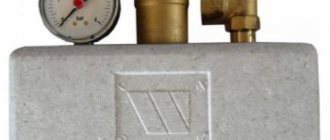How to choose a gas boiler?
First of all, you must decide where it will stand. Some models require the construction of a special chimney, and such a project is difficult to coordinate. If a full-fledged heating unit cannot be installed in a room, parapet devices come to the rescue.
They do not require a vertical chimney and are often independent of power supply.
We have compiled a rating for 2022 of the best parapet gas boilers presented on the Russian market in terms of price/quality ratio. When compiling the list, we were guided by functionality, ease of installation and operation, as well as customer reviews.
In our rating you will find only market leaders!
What is a parapet gas boiler?
Parapet gas boilers are heating units that combine the features of atmospheric and turbocharged models. They are completely energy independent, but are equipped with a closed combustion chamber.
A special feature of this design is the use of a coaxial chimney, which is connected to the rear of the unit and vented to the street. Smoke removal and fresh air intake occur as a result of convection processes.
When the boiler is put into operation, no odors are felt in the room; there are not even traces of soot or other combustion products .
In addition, oxygen does not burn out in the room, which allows you to maintain a normal microclimate.
Another feature of parapet boilers is the ability to be used as independent heating elements. There are special holes in the lower part of the case through which hot air escapes.
It circulates in the room and provides it with the desired temperature.
Under what conditions is it most advisable to use such boilers?
Parapet models are used to organize heating and hot water supply (DHW) systems in buildings whose design does not involve the construction of a full-fledged chimney, as well as with problems in power supply and other aspects: stable pressure, soft water and high-quality fuel.
However, it is necessary to take into account the power limitation in the range from 4 to 46 kW, i.e., in terms of similar indicators, “parapets” are seriously inferior to both wall-mounted and, even more so, floor-standing units.
This means that it is reasonable to install them only in relatively small rooms (from 30 to 250 m2), such as private and country houses, retail sites, offices in shopping centers and, of course, high-rise apartments, in which they fit perfectly into the niche under the windowsill in the kitchen. How to choose a room thermostat and save up to 30% per month on heating
Possibility of installing a parapet boiler in a wooden house
Almost any wooden house can be equipped with a parapet boiler: the exception is barracks and other old-style apartment buildings.
Installation is carried out according to the current SNiP rules 42-101-2003:
- the unit is placed on an external wall, while an empty gap should remain outside - from 0.3 to 3.1 m (depending on the power), without facade elements;
- The chimney outlet must not be installed near or directly in enclosed spaces (entry, attics, entrances, balconies, loggias, etc.);
- the mounting wall is sheathed with fire-resistant material and covered with a sheet of steel so that there is a distance of 10–25 cm to difficult and easily flammable areas;
In wooden houses, internal and external thermal insulation of a coaxial chimney is mandatory - porous wood, in order to increase fire safety, is prepared in advance for overlapping, treated with special mastics and impregnations in 2-3 layers.
Many companies still use asbestos to protect walls from fire, although today it is officially recognized as a material hazardous to health. Ceramic or silicate bricks, GVP-slabs, mineral wool, basalt insulation, foam and aerated concrete panels, and even gypsum plaster can help replace it.
How to prepare the boiler for operation
The detailed instructions that come with each model will help answer most questions that arise during the operation of equipment from Termotechnik. Reading the manual is useful for every owner to avoid mistakes and breakdowns.
It is especially important to read the instructions before diagnosing or repairing. For example: the burner goes out and it is impossible to immediately determine why this is happening - there can be about a dozen reasons for such a problem.
Before turning on the boiler, you must fulfill all the manufacturer's requirements regarding the premises used for installing the equipment. You also need to properly connect and configure the device.
All installation and adjustment work must be performed by specialists who have a special permit to perform the work. The first ignition is carried out after completion of installation and piping. Be sure to check whether the equipment is installed correctly. It is necessary to ensure that all fastenings comply with fire safety regulations.
It is prohibited to place flammable materials near heaters. It is prohibited to place gas appliances near windows - this will interfere with their operation. When installing equipment, you need to pay attention to the body - it must stand level, distortions are unacceptable.
When the equipment is installed, you need to connect cold water to it by removing the plugs from the pipes. Filters are installed at the inlet to prevent dirt particles from entering the system. Ball valves must be installed on each branch pipe used for piping. It is especially important to install gas pipes correctly - you should not do this yourself, invite a specialist.
Premises requirements
The room intended for installation of Termotechnik heaters must have a constant flow of air. The room is equipped with a ventilation hood.
Gas appliances can only be mounted near non-flammable walls, retreating 15 cm from them. Non-flammable walls must be covered with steel sheets - they are attached to asbestos sheets, the thickness of which is 5 mm. The dimensions of the sheet should be 10 cm larger than that of the heater. The passage in front of the facade should be more than one meter.
If the heater is mounted on a wooden floor, first lay the asbestos sheet, and then the metal one.
Advantages and features of parapet units
The main advantage of the equipment is its compactness: a parapet boiler running on gas can easily fit in the kitchen under a window sill or in any other room, since during operation it does not consume oxygen from the room and does not pose a danger to residents. A coaxial chimney is a reliable and safe smoke removal system, which also offers a choice in favor of such equipment.
The correct choice of product should be based on the following parameters (except for consumer reviews and catalogs from selling companies):
- Installation technology: the parapet boiler is made for mounting on walls and floors; there are also left- and right-hand models;
- A gas parapet boiler can be equipped with one or two circuits. One circuit is for heating only, the second circuit is for domestic hot water;
- Also, parapet boilers can be energy-dependent (with an automatic monitoring, adjustment and control system) and non-volatile (with or without manual adjustment).
Technical characteristics of universal boilers
The thermal power possessed by parapet boilers varies between 15 kW-40 kW for a unit with one circuit. If you choose to install parapet equipment with two water heating circuits, then the capacity for heating water for domestic needs should also be added to the rated power. For example, parapet boilers with a power of 12 kW -15 kW easily heat the volume of water up to 180 l/h, which, according to the standards, is four water points (faucets, toilets, faucets, showers, etc.).
- The single-circuit unit has a standard heat exchanger (jacket) of a plate design, which speeds up the process of heat exchange between the gas burner and the working fluid of the heating system. The material of the shirt is thick 3 mm steel.
- Double-circuit gas parapet boilers contain, in addition to the heat exchanger, a copper or brass coil for hot water supply, in which water is heated only by the flow method. If you increase the productivity of the hot water supply due to an additional hot water tank, then such a boiler will no longer be able to be installed in the kitchen.
Also, in addition to wall-mounted and floor-mounted models, there are products with differences in installation: with left-side connection of the gas pipe, hot water supply and heating circuit, and with right-side connection. This convenience should not be overlooked when choosing a boiler for an apartment or house. The dimensions of the unit are determined by its performance and the number of water heating circuits. For example, if a boiler has one circuit, then its dimensions will be smaller than that of a double-circuit one.
Types of boilers by power
Features of the device
The body of such equipment has a rectangular shape, which adds convenience during installation, and the method of its mounting can be left, right or universal (double-sided).
The most popular are parapet boilers, whose power does not exceed 15 kW, although on the plumbing market there are more powerful samples designed for 35 kW or more.
Difference from analogues
At the time of development, boilers with convectors were conceived as a replacement for wall-mounted equipment for a similar purpose. After all, their predecessors require frequent maintenance, they are capricious and require high quality gas.
It is believed that the new type of heating equipment is less demanding to operate and does not require frequent maintenance. In addition, there is no connection to the chimney, which is a significant advantage and makes it possible to install it in any convenient room that has an external wall.
Installation location
In most cases, the parapet boiler is fixed in a niche under the window, where the radiator is usually placed. The main difference from wall-mounted and floor-mounted devices is the power range, installation method and output channel equipment. Currently, such a unit is a convector and a gas boiler at the same time, and can be installed not only in country houses, but also in apartment buildings.
The only thing worth remembering is that the device is completely energy dependent, because its operation will require a continuous supply of electricity. In this, it is completely similar to similar turbocharged devices designed to operate in a heating system with forced circulation of energy.
What is the difference from the usual?
The main difference between parapet models and conventional boilers is the ability to obtain increased safety from a non-volatile design and no impact on the internal atmosphere of residential premises.
If a conventional atmospheric boiler consumes ambient air, actively burning oxygen and requiring constant ventilation, then parapet models are completely separate and do not disturb the air exchange regime.
Another difference is the ability to independently heat air, making a parapet boiler similar to a stove.
Operating principle of parapet gas equipment
- The burner device is ignited with a wick or igniter.
- Gas, when burned, releases heat, which heats the boiler.
- Network water, using a circulation pump or with natural circulation, heats up, leaves the boiler and enters heating devices located in residential, public or industrial premises.
- The gas combustion process will continue until the water in the heating circuit heats up to a predetermined level, after which it will be automatically turned off by a gas valve installed in front of the boiler.
- The wick continues to function and will re-ignite the burner when the mains water temperature drops.
Pros and cons of parapet boilers:
- Possibility of indoor use.
- Affordable prices.
- Small geometric dimensions of the installation.
- Speed and ease of installation work.
- Possibility of use without installing additional radiators.
- Large power range.
There is only one drawback - energy dependence.
Types of equipment
There are several types of heating installations. Each type of boiler has its own purpose, features and functions. Knowing the features of the installations, you can choose the best option for a particular room.
Types of gas boilers:
- AGV-AOGV. This is the best solution for large houses and premises. The devices do not require connection to the electrical network.
- Condenser. The devices reduce heating costs by 35%. Such boilers use the thermal energy of steam.
- Gas water heaters. The devices are used only for heating water.
- Single-circuit. Standard devices for organizing heating.
- Dual-circuit. Such boilers perform two functions: they provide heat and heat water. Depending on the modification, the unit is equipped with a flow-through heat exchanger or boiler.
Design and operating principle
In terms of design features and technical characteristics, parapet boilers are similar to wall-mounted gas heaters. The boilers are equipped with:
- body made of sheet steel with a minimum thickness of 3 mm;
- closed combustion chamber;
- gas burner and igniter;
- a heat exchanger made of steel (if the device has two circuits, then the secondary coil is copper);
- coaxial chimney;
- safe use system (thermometer, thermocouple, draft sensor).
Such boilers consist of 6 elements
The inside and outside of the case is treated with a special powder coating that protects it from corrosion. Thick steel prevents mechanical damage. All this ensures a decent appearance and reliability of the unit.
The principle of operation of a parapet boiler is simple: the burner is ignited by the ignition device, the flame is directed to the heat exchange device, inside which the coolant circulates. As soon as its temperature reaches the required limit, the automatic heating element is activated. The gas valve closes automatically, the burner goes out, and the igniter continues to operate. When the water cools to the lower critical level, the gas supply to the burner will resume, the burner will light up from the igniter, and the water will begin to heat up.
Types of boilers by chimney type
The chimney of a parapet boiler can have forced or natural draft. The first option is a coaxial system, while the second consists of a traditional pipe that runs through the roof. You can often find references to turbocharged boilers. They are what we understand as wall-mounted parapet models, however, the products of fuel combustion in them are removed using special fans through a coaxial chimney. If the draft is natural, then the burner of the equipment is open, and air is supplied from the room. If the pipe is coaxial, then air is sucked in from outside. Such boilers, as a rule, are used in conjunction with parapet devices, which improves environmental conditions in the room; the air is no longer burned, as it comes from outside. Chimneys can be vertical or horizontal, which expands the possibilities when choosing a place to install a heat generator.
Single and Dual Circuit Devices
Parapet boilers are produced in a standard rectangular shape, single- and double-circuit, left- and right-handed, which makes their installation easy and convenient.
Single-circuit ones are intended only for heating. They are equipped with a plate heat exchanger, which ensures the rate of heat exchange between the gas burner flame and the coolant.
The double-circuit parapet boiler has an additional copper coil, which provides the house with hot water supply. Water is heated only by flow. If you use a storage tank, the size of the equipment will increase significantly, which will make it impossible to install it in an ordinary apartment.
Rules and installation locations
Equipment of this type is used in rooms where a traditional chimney is not provided. A parapet gas boiler can be installed anywhere in the house thanks to a closed combustion chamber and a coaxial chimney, but the main condition is its location near the wall. This ensures that the coaxial pipe is brought out to the street.
A coaxial chimney is a stainless steel structure consisting of two pipes of different diameters located one inside the other. Thanks to this design, a space is provided through which air mass flows to ensure gas combustion. Combustion products are removed through a pipe of smaller diameter. The coaxial chimney is directed through the wall to the street, and wind protection must be installed. After this, the installation of flue pipes, heating circuits and hot water supply is carried out.
Installing the equipment is quite simple, but doing it yourself is strictly prohibited. You should contact licensed specialists. Connection to the gas main is made exclusively by gas service employees.
This is important: what standards exist for installing heating boilers in a private home.
Installation rules
A parapet boiler, the price of which ranges from 12-65 thousand rubles, is a source of increased danger, so to install it you need to obtain permission from the fire inspection authorities, gas service and others (if necessary). In addition, the installation of the device is carried out in compliance with certain rules:
- The installation can be located in any room, but only near an external wall in which it is possible to make a hole for the chimney. The inside should be treated with special non-flammable materials - steel plates.
- Those objects that can quickly catch fire (furniture, curtains) should be kept at a distance of 30 cm from the boiler. Otherwise, a fire may occur.
- The distance between the device and the facade can vary between 0.3-2.5 m.
- The boiler can only be installed in a room with good ventilation.
- The chimney of the device must be vented only to the street. You cannot install it on closed balconies or porches.
Rules for choosing parapet gas boilers
Before purchasing, the user should decide on the type of model - wall-mounted or floor-mounted, calculate the heated area, and assess the degree of insulation of the object.
Equipment is selected taking into account the following nuances:
- Heat exchanger wall thickness. The steel must be at least 3 mm thick, otherwise the efficiency of the device decreases due to the slowdown of thermal processes.
- Working pressure indicator. The parameter is stated in the technical data sheet and should be higher than 4–5 bar. The higher the number, the better the quality of the heat exchanger steel.
- Efficiency The optimal size is from 92%. The efficiency and performance of the device depends on the indicator.
- Dimensions. The compact wall-mounted gas parapet boiler does not limit the installation area; models are installed in the kitchen, bathroom, and other rooms. Floor-standing ones require free access to the equipment, which means that there must be at least 30 cm of space between the device body and the nearest equipment.
- Connection type. Models with side and bottom connections are available for sale.
- Power. This is an important parameter. If the power of the device is low, the thermal energy will not be enough; if it is excessive, the unit will not work at full capacity, which will lead to rapid wear of the equipment.
Advice! To calculate power, the area of the room is divided by 10, the final figure means the number of kW. For example, for houses of 50 m2 you need a boiler with a power of 5 kW. The parameter is average, so in case of poor insulation, harsh winters, or an extensive network, another 35–50% is added.
Which company should you choose?
Parapet boilers were invented in the CIS as an alternative to gas units for those places where there are problems with power supply, stable pressure in gas networks and hard tap water.
The most famous models are produced in Russia and Ukraine:
- ATON (Ukraine) - expensive and functional devices;
- Lemex (Russia) - simple, economical and reliable boilers made of steel with anti-corrosion coating;
- Gefest WPR (Russia) - expensive and high-quality boilers with Italian automation;
- TERMO MAX (Ukraine) - primitive, but comfortable and economical models.
We recommend boilers .
They are suitable for open and closed heating systems, with a pressure not exceeding 1.5 atm, and are equipped with Italian automatic equipment. Parapet devices require regular maintenance, and there are more than 400 service centers of this manufacturer in the former CIS countries.
Functionality and equipment of gas wall-mounted parapet-type boilers
The devices can be equipped with gas burner devices of various designs:
- single-stage,
- two-stage,
- modulated.
Operating modes are also different. There are devices only for heating, but there are models capable of preparing hot water to meet economic and domestic needs.
Gas wall-mounted boilers of this type are equipped with heat exchangers made of cast iron, copper and steel. Each type has its own pros and cons and should be selected based on operating conditions. To ignite the gas apparatus, an electronic or piezoelectric ignition system is usually provided.
How can floor or parapet boilers differ from each other in principle?
- Reliability
- Economical
- Technical characteristics (power, geometric dimensions, connection diameters)
Reliability
Reliability depends on the thickness and quality of the steel from which the heat exchanger is made. Today, very few manufacturers indicate what metal they make boilers from. Previously, almost all manufacturers indicated this characteristic, but now it has faded into the background. Steel with a thickness of 3 mm is considered good. In addition, in addition to thickness, the quality of the metal also plays an important role. The quality of the heat exchanger can be most adequately judged by the maximum pressure that the manufacturer allows in the heating system.
Economical
This parameter directly depends on the design of the heat exchanger and automatic control. 95% of modern heating devices are manufactured using automation from the Italian company EUROSiT. It has established itself as the most unpretentious and durable device.
Heat exchangers are now used of the “tubular” type, with turbulators, by all domestic manufacturers. In order not to go into unnecessary details, I advise you to look at the efficiency (efficiency factor). This and only this parameter (and not reviews from neighbors) will adequately show how economical gas consumption will be. An efficiency of 90-92% would be good. Almost all manufacturers have achieved this mark. Those. In terms of efficiency, they are almost the same. Why can’t you judge efficiency by reviews? Because each house has a different degree of thermal insulation and, therefore, different heat loss. Plus, each person has his own “bar” for the concept of a lot or a little.
Specifications
Technical parameters include the dimensions of the boiler, the dimensions and location of connections, and the power of the device. And if in terms of dimensions and connections everything depends on the installation location, then you should focus on power separately.
Advantages and disadvantages of parapet models
The positive features of the equipment are as follows:
- wide scope of application due to the absence of the need for additional structures;
- small dimensions and weight;
- very affordable cost, especially compared to other devices;
- Possibility of use without a heating circuit for one room due to the presence of convection holes in the housing.
The disadvantage of heating with parapet gas boilers is the same as with other heat generators using “blue fuel”: the need to obtain permission from regulatory organizations. It may take several months to agree on all installation details, obtain a positive decision and seal the equipment.
Characteristics to consider
The best parapet gas boilers are reliable and have a number of distinctive qualities. Before choosing a device, you need to pay attention to:
- Thickness of the material. The metal in the equipment should not be more than 3 millimeters. If the thickness is greater, then the heat transfer process slows down and the efficiency of the device decreases.
- Quality of material. You can determine the properties of the metal by looking at the level of maximum pressure recommended by the manufacturer. The higher the indicators, the better the quality of the material.
- Heat exchanger design. When choosing a boiler, it is important to calculate its efficiency (efficiency factor). The efficiency and economy of the equipment depends on this indicator. Most gas boilers have an efficiency of at least 90-92%. Ideally, you need to choose a technique with a large value, because even a couple of percent is a noticeable increase in efficiency.
Choosing the best and most reliable gas boiler Buderus gas boilers: characteristics
- Device dimensions. Size is an individual characteristic for each buyer, affecting the conditions and location of the boiler installation.
- Location of connectors for connection. You also need to pay attention to the position of the connections. There are boilers in which the connectors are on the left or right. There are versatile models that connect from either side.
- Unit power. The quality of heating and costs depend on this indicator. If you take a boiler that is too powerful, then a significant part of the electricity and fuel will be wasted. When calculating the optimal indicator, you need to take into account the thickness of the walls, the height of the ceilings, the number of windows, the presence of drafts, etc. The calculation formula looks like this: for every 10 square meters of space, 2 kW of power is required.
Please note: A parapet boiler is an easy-to-install and operate equipment that performs the functions of a water heater, convector and oven
…
Rating of the TOP best parapet gas boilers
Lemax Patriot 12.5
Lemax Patriot 12.5 is a high-performance single-circuit gas boiler with a power of 12.5 kW and designed for heating a room with an area of 120 m2.
The device is equipped with a smoke removal kit and a sealed chamber, ensuring that there is no risk of combustion products entering the heated room.
The design is highly durable thanks to high-quality steel heat exchanger walls with a thickness of 2 mm.
The operating life of the boiler reaches record levels due to the use of a reliable gas valve manufactured by the Italian company SIT and an overheating protection system.
Specifications
| Power | 12.5 kW |
| Efficiency | 87% |
| Heat exchanger material | Steel |
| Maximum heating temperature | 80° |
| Manufacturer country | Russia |
| Weight | 50 kg |
| Guarantee | 36 months |
pros
- Availability of a protective system;
- Smoke removal system;
- Convection effect achieved due to the presence of holes on the boiler panel;
- Long service life;
- Reliability and comfort;
- Energy independence
Minuses
- No
Lemax Patriot 20
Floor-standing gas boiler with high power and a guarantee of reliability . The device is equipped with a smoke removal system.
The manufacturing is based on 2 mm thick steel, the production of which belongs to
Magnitogorsk Iron and Steel Works. The heat exchanger has an enamel coating, which helps protect the boiler components from unwanted influences.
The Lemax Patriot 20 model includes a security system and overheating protection.
Gas heating boiler, contour. The parameters of the device (H*W*D) are 790*710*410 mm.
Specifications
| Power | 20 kW |
| Efficiency | 87% |
| Maximum heating temperature | 90° |
| Number of circuits | One |
| Manufacturer country | Russia |
| Weight | 67 kg |
| Guarantee | 36 months |
pros
- High efficiency;
- Convection effect;
- High reliability and quality;
- Long service life;
- Overheat protection;
- Energy independence
Minuses
- No
TERMOMAX S-12E
Another unit, devoid of any hints of design. Despite this circumstance, you should not write it off, because the lack of external attractiveness is compensated by economy, efficiency and real comfort of operation: the main control elements are located directly on the front of the outer panel.
On request, the boiler can be supplemented with an expansion tank and a circular pump (not included in the basic package), which will make it suitable for connection to complex heating systems, including those with high hydraulic resistance. Maximum gas consumption at a power of 12.0 kW is 1.39 m3/h.
Cost: 15,860 – 20,340 rubles.
Manufacturer: TERMOMAX (TERMOMAX), Ukraine.
Hephaestus VPR KSG-10S
Perhaps this option is one of the best parapet gas boilers for heating a private home: it is clear, almost silent (distinctively quiet at start-up) and quite highly efficient, given the ability to operate in the “small flame” mode, which allows reducing the average gas consumption to 0.60 m3/h.
Despite the fact that the unit itself has a Russian-made assembly, it contains the well-known Italian automation of the “SIT” type, which, based on the current heat losses, maintains an optimal power level (within 10 kW), as well as a slot burner of the “BRAY” type , which does not require air flow adjustment.
Cost: 19,680 – 23,840 rubles.
Manufacturer: Gefest WPR (Hephaestus VPR), Russia.
Lemax Patriot 6
Lemax Patriot 6 is a parapet gas boiler that includes the functions of a convector and a wall-mounted boiler.
The coaxial pipe combines the roles of air intake and chimney.
The heating area of the boiler is 60 m2. The unit is suitable for heating residential and public premises.
The presence of an opening in the lower part of the boiler ensures high efficiency due to the symbiosis of the functions of a water heater and a stove, which are assumed by the gas boiler of the Lemax Patriot 6 model.
The device is notable for its compactness and, as a result, low weight. Boiler parameters: 730*550*310 mm.
Specifications
| Power | 6 kW |
| Efficiency | 87% |
| Maximum heating temperature | 90° |
| Number of circuits | One |
| Manufacturer country | Russia |
| Weight | 41 kg |
| Guarantee | 24 months |
pros
- High efficiency;
- Energy independence;
- Availability of a protective housing;
- Availability of a protective system;
- Reliability
Minuses
- Low power rating
Lemax Patriot 16
This model is a floor-standing single-circuit gas boiler with a rectangular heat exchanger, which is based on high-quality steel material 2 mm thick.
The power of the device is 16 kW, which is why it is designed to heat a room with an area of 160 m2.
The boiler is equipped with a chimneyless design, which allows it to be used both in apartments and private houses.
Product parameters: 790*670*400 mm.
Specifications
| Power | 16 kW |
| Efficiency | 87% |
| Maximum heating temperature | 80° |
| Number of circuits | One |
| Manufacturer country | Russia |
| Weight | 67 kg |
| Guarantee | 36 months |
pros
- High efficiency;
- Energy independence;
- Compactness;
- Overheating protection system;
- Availability of inspection window
Minuses
- No
Lemax Patriot 7.5
Gas single-circuit boiler with a power of 7.5 kW . The device runs on natural gas and is equipped with a closed combustion chamber.
The walls of the heat exchanger are made of steel and have a thickness of 2 mm.
The unit is equipped with automatic safety, an overheat protection system and an easily removable top panel.
The heat exchanger is covered with anti-corrosion enamel, which protects it from harmful influences.
The device is non-volatile and has the following parameters - 730*550*310 mm.
Specifications
| Power | 7.5 kW |
| Efficiency | 87% |
| Maximum heating temperature | 90° |
| Number of circuits | One |
| Manufacturer country | Russia |
| Weight | 42 kg |
| Guarantee | 36 months |
pros
- High efficiency;
- Convenience and reliability;
- Long-term operation;
- Compactness;
- Energy independence;
- Overheat protection system
Minuses
- Low power rating
ATON Compact 12.5E
Floor-standing parapet gas boiler with a power of 12.5 kW . Designed for heating a room with an area of 160 m2.
The device is equipped with a tubular flow coil made of copper.
The device has only one circuit and is not intended for heating water.
The operation of the boiler does not depend on electricity. Type of construction: gas, convection. The equipment is easy to use.
Boiler parameters: 700*630*275 mm.
Specifications
| Power | 12.5 kW |
| Efficiency | 90% |
| Maximum heating temperature | 90° |
| Number of circuits | Two |
| Manufacturer country | Ukraine |
| Weight | 70 kg |
| Guarantee | 12 months |
pros
- No dependence of operation on electricity;
- High efficiency;
- Combination of heating and water heating functions;
- Compactness;
- Versatility of use regarding installation locations;
Minuses
- Heavy weight;
- Low warranty period
Types and prices
The advantage of such boilers is a large selection of models with different mountings: floor-mounted and wall-mounted. When choosing a boiler, real connection conditions are taken into account.
Boiler equipment from European factories, Russia, CIS countries and China is quite widely represented on the construction market. It is clear that the quality of equipment from the EU is higher than that of boilers from China, but the price is also much higher.
Popular parapet boilers:
- TERMOMAX-C are non-volatile compact boilers for individual heat supply of single-storey and multi-storey buildings, equipped with a flue gas exhaust system through a coaxial channel, horizontally built into the external wall.
Structurally, they are carried out in both single and double-circuit versions with markings E and EB and thermal power from 7 to 16 kW. For heating systems with high hydraulic resistance, a circulation pump is provided. Control, protection and start-up are carried out through the gas valve EuroSit 630. The burner is started using piezo ignition. TermoMax C 16EB has an efficiency of 90% and is capable of heating rooms measuring 120 m2, the cost of the unit is 20,100 rubles. - Another Russian model of a parapet boiler is Lemax Patriot 20 with a closed firebox. The steel heat exchanger is treated with an inhibitory compound and covered with an enamel coating to resist corrosion processes. Mounting type: wall-mounted. The range of thermal loads of Lemax boilers is from 6 to 20 kW. Gas burner equipment from the Italian concern “SIT” with an injection flare burner “POLIDORO”. There are special holes on the front panel to create a convection effect and increase heat transfer in the room. Features include: removable cladding elements, igniter, coaxial smoke removal system, non-volatile installation option. The cost of the unit is 25,820 rubles.
- The double-circuit boiler “Slim 2.300 Fi” is produced by the Baxi brand with a heat load from 14.9 to 29.7 kW, capable of heating objects measuring 140 -160 m2. The boiler is made of high-quality materials, with a price from 120.0 to 140.0 thousand rubles.
- EcoCompact VSC D INT 306/4-5 190L, boiler of the German brand Vaillant - a highly efficient unit, can heat 160-180 m2, price 240.0 thousand rubles.
- The Danko parapet boiler, with a power from 7 to 18 kW, is equipped with a cast iron boiler with a wall thickness of 3 mm and a closed combustion chamber. The universal design allows for two-way connection of utility networks; the control unit is located on the operating panel of the boiler. The units are equipped with Honeywell gas automatics, piezoelectric ignition and a micro-torch burner, heating area up to 160 m2, price – 21 thousand rubles.
- Eurotherm KT TSY (P2) for individual heat supply in systems with natural and forced circulation of the heating circuit, with water heating temperature up to 90 C, thermal power 10 kW, gas consumption 1.13 m3/hour, efficiency 92%, weight 59 kg, warranty period 24 month, heating area 100 m2, price – 24 thousand. rub. Steel boilers are equipped with a copper recovery system with a bypass channel. A specially designed copper coil is placed in a water cavity to produce hot water. Design features: heat recovery system with a receiving tank, housing, control and protection unit, air duct, flue, wind protection cover. The design allows you to install the unit at floor level near the wall. The DHW circuit connecting pipelines are made on one side. The air intake duct passes through the outer wall with a thickness of 200 - 500 mm. Mounting on walls in a wooden house is not allowed without fire protection measures.
